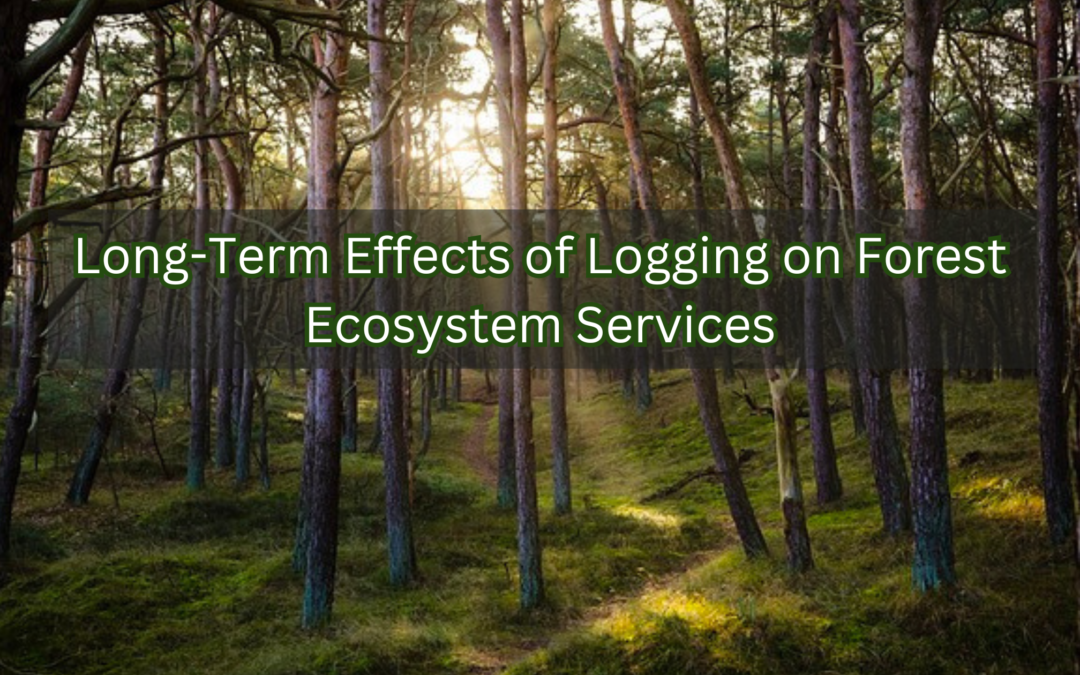The forest ecosystem services are vital for maintaining biodiversity, regulating climate, and providing essential ecosystem services such as carbon storage, water filtration, and soil fertility. These intricate networks of plants, animals, fungi, and microorganisms work together to create resilient environments. However, activities like logging can disrupt these ecosystems, leading to biodiversity loss, reduced carbon sequestration, and weakened soil and water systems. Sustainable management practices are essential to protect and restore these crucial ecosystems for future generations.
Forests, often called the lungs of the Earth, are vital for sustaining life on the planet. They regulate the climate, provide habitat for countless species, and support essential ecosystem services such as carbon storage, soil fertility, and water management. However, logging—the process of harvesting trees for lumber, paper, and other uses—poses significant threats to these services. While forests can regenerate, the impacts of logging are long-lasting, often taking decades or even centuries to fully recover.
This article explores the profound effects of logging on forest ecosystem services and highlights sustainable forestry practices that can mitigate these impacts.
The Role of Forests in Climate Regulation and Carbon Storage
Forests play a critical role in sequestering carbon and helping mitigate climate change by absorbing carbon dioxide from the atmosphere. Logging disrupts this process in multiple ways:
- Loss of Carbon Storage: Mature trees act as massive carbon sinks. When logged, their stored carbon is released into the atmosphere through decomposition, burning, or the use of wood products.
- Reduced Carbon Sequestration Potential: Logged areas often regenerate with younger trees, which store less carbon than mature forests, reducing the forest’s overall capacity to act as a carbon sink.
To understand the global implications of deforestation, visit the United Nations Sustainable Development Goals page on forests and climate action.
Impacts on Biodiversity
Logging fundamentally alters the structure and complexity of forest ecosystems, which has severe consequences for biodiversity:
- Habitat Simplification: Many species, including birds, fungi, and mammals, depend on the intricate habitats provided by old-growth forests. Logging creates less complex environments, which often cannot support these species.
- Habitat Fragmentation: Techniques such as clear-cutting divide forests into smaller, isolated patches, making it harder for wildlife to migrate and thrive. This isolation increases the risk of extinction for certain species.
- Selective Logging Effects: Even targeted logging can disrupt ecosystems by removing keystone species that are essential for maintaining ecological balance.
Explore the importance of biodiversity conservation and its role in ecosystem resilience on the WWF Biodiversity page.
Soil Fertility and Erosion in Forest Ecosystem
Forests maintain soil health by providing organic matter and stabilizing the ground with tree roots. Logging disrupts these processes:
- Nutrient Depletion: The removal of organic materials, such as leaves and fallen branches, strips the soil of nutrients essential for vegetation growth.
- Increased Erosion: Without tree roots to anchor the soil, rainwater washes away the topsoil, particularly on slopes. This reduces soil fertility and makes it harder for forests to regenerate.
- Soil Compaction: Heavy machinery used in logging operations compacts the soil, further hindering plant growth and water infiltration.
For more information on the impacts of deforestation on soil health, check out FAO’s Resources on Soil and Forest Interactions.

Hydrology and Water Regulation
Forests play an essential role in regulating water cycles by maintaining soil moisture, filtering water, and reducing runoff. Logging interferes with these functions:
- Increased Runoff and Sedimentation: Without tree cover, rainfall flows more rapidly over the surface, leading to sedimentation in rivers and streams, which affects aquatic ecosystems.
- Reduced Groundwater Recharge: Logging disrupts the natural processes that replenish underground water reserves, affecting water availability in surrounding regions.
- Altered Stream Dynamics: Changes in forest cover can lead to fluctuations in stream flow, impacting both aquatic life and human communities that rely on these water sources.
Learn about sustainable water management practices on the Global Water Partnership website.
Sustainable Forestry Practices for Mitigation
Although the effects of logging are profound, adopting sustainable practices can significantly reduce its long-term impact:
- Reduced-Impact Logging: Careful planning and execution of logging operations minimize damage to surrounding ecosystems and soil.
- Selective Logging: Removing specific trees rather than clear-cutting preserves the overall structure of the forest and allows ecosystems to recover more quickly.
- Reforestation: Planting trees in logged areas helps restore carbon sequestration, biodiversity, and soil health.
- Mixed-Species Plantings: Encouraging the growth of diverse tree species enhances biodiversity and resilience.
- Preservation of Old-Growth Forests: Protecting these vital ecosystems ensures they continue to provide essential services and act as biodiversity hotspots.
To dive deeper into sustainable forestry, visit Rainforest Alliance’s Guide to Sustainable Forestry.
The Path Forward
The long-term effects of logging on ecosystem services—spanning carbon storage, biodiversity, soil health, and water regulation—underscore the need for conservation and sustainable management. However, with thoughtful planning and the adoption of sustainable practices, it is possible to mitigate these impacts and restore forests’ vital functions.
Governments, industries, and individuals all have a role to play in protecting forests for future generations. From reforestation initiatives to policies promoting reduced-impact logging, every effort counts. Forests are not just resources; they are complex, life-sustaining systems that deserve our respect and protection.
To learn more about sustainable practices and agroforestry solutions, visit EAT Community.
Related Articles and Resources:
- How Forest Ecosystems Help Regulate Climate Patterns
- Green Infrastructure: The Key to Urban Resilience and Sustainability
- Forests face increasing risk of wildfires and pests due to climate change
- WWF Biodiversity page.
- Forest Ecosystems and Pollination Services: How They Benefit Agriculture and Biodiversity
- FAO’s Resources on Soil and Forest Interactions.
- Global Water Partnership
- Rainforest Alliance’s Guide to Sustainable Forestry



